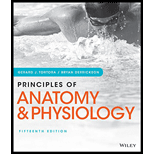
Principles of Anatomy and Physiology
15th Edition
ISBN: 9781119329398
Author: Gerard J Tortora, Bryan Derrickson
Publisher: John Wiley & Sons Inc
expand_more
expand_more
format_list_bulleted
Concept explainers
Question
Chapter 26, Problem 17CP
Summary Introduction
To review:
Diagrammatic representation of reabsorption of solutes through the paracellular and transcellular routes. Also, label basolateral and apical membrane and determine sodium-potassium (Na+-K+ ATPases or adenosine triphosphatases) pump's location.
Introduction:
Any substance that is reabsorbed from tubular fluid present in lumen enters a peritubular capillary by two routes. The routes include movement between neighboring tubule cells or via an individual tubule cell.
Expert Solution & Answer
Want to see the full answer?
Check out a sample textbook solution
Students have asked these similar questions
Explain in a small summary how:
What genetic information can be obtained from a Punnet square? What genetic information cannot be determined from a Punnet square?
Why might a Punnet Square be beneficial to understanding genetics/inheritance?
In a small summary write down:
Not part of a graded assignment, from a past midterm
Chapter 26 Solutions
Principles of Anatomy and Physiology
Ch. 26 - Explain the role of each organ of the urinary...Ch. 26 - 2. What are examples of wastes that may be present...Ch. 26 - 3. Describe the location of the kidneys. Why are...Ch. 26 - 4. Identify the three layers that surround the...Ch. 26 - Prob. 5CPCh. 26 - Prob. 6CPCh. 26 - Prob. 7CPCh. 26 - Prob. 8CPCh. 26 - Prob. 9CPCh. 26 - 10. Where is the juxtaglomerular apparatus (JGA)...
Ch. 26 - How do tubular reabsorption and tubular secretion...Ch. 26 - Prob. 12CPCh. 26 - What is the major chemical difference between...Ch. 26 - Prob. 14CPCh. 26 - Prob. 15CPCh. 26 - How is glomerular filtration rate regulated?Ch. 26 - Prob. 17CPCh. 26 - Describe two mechanisms in the PCT, one in the...Ch. 26 - 19. How do intercalated cells secrete hydrogen...Ch. 26 - Graph the percentages of filtered water and...Ch. 26 - 21. How do symporters in the ascending limb of the...Ch. 26 - 22. How does ADH regulate facultative water...Ch. 26 - Prob. 23CPCh. 26 - What are the characteristics of normal urine?Ch. 26 - Prob. 25CPCh. 26 - How may kidney function be evaluated?Ch. 26 - Prob. 27CPCh. 26 - What forces help propel urine from the renal...Ch. 26 - What is micturition? How does the micturition...Ch. 26 - 30. How do the location, length, and histology of...Ch. 26 - Prob. 31CPCh. 26 - Prob. 32CPCh. 26 - Which tissue gives rise to collecting ducts,...Ch. 26 - 34. To what extent do kidney mass and filtration...Ch. 26 - Prob. 1CTQCh. 26 - For each of the following urinalysis results,...Ch. 26 - Prob. 3CTQ
Knowledge Booster
Learn more about
Need a deep-dive on the concept behind this application? Look no further. Learn more about this topic, biology and related others by exploring similar questions and additional content below.Similar questions
- Noggin mutation: The mouse, one of the phenotypic consequences of Noggin mutationis mispatterning of the spinal cord, in the posterior region of the mouse embryo, suchthat in the hindlimb region the more ventral fates are lost, and the dorsal Pax3 domain isexpanded. (this experiment is not in the lectures).a. Hypothesis for why: What would be your hypothesis for why the ventral fatesare lost and dorsal fates expanded? Include in your answer the words notochord,BMP, SHH and either (or both of) surface ectoderm or lateral plate mesodermarrow_forwardNot part of a graded assignment, from a past midtermarrow_forwardNot part of a graded assignment, from a past midtermarrow_forward
- please helparrow_forwardWhat does the heavy dark line along collecting duct tell us about water reabsorption in this individual at this time? What does the heavy dark line along collecting duct tell us about ADH secretion in this individual at this time?arrow_forwardBiology grade 10 study guidearrow_forward
arrow_back_ios
SEE MORE QUESTIONS
arrow_forward_ios
Recommended textbooks for you
 Concepts of BiologyBiologyISBN:9781938168116Author:Samantha Fowler, Rebecca Roush, James WisePublisher:OpenStax College
Concepts of BiologyBiologyISBN:9781938168116Author:Samantha Fowler, Rebecca Roush, James WisePublisher:OpenStax College Human Physiology: From Cells to Systems (MindTap ...BiologyISBN:9781285866932Author:Lauralee SherwoodPublisher:Cengage Learning
Human Physiology: From Cells to Systems (MindTap ...BiologyISBN:9781285866932Author:Lauralee SherwoodPublisher:Cengage Learning Human Biology (MindTap Course List)BiologyISBN:9781305112100Author:Cecie Starr, Beverly McMillanPublisher:Cengage Learning
Human Biology (MindTap Course List)BiologyISBN:9781305112100Author:Cecie Starr, Beverly McMillanPublisher:Cengage Learning- Essentials of Pharmacology for Health ProfessionsNursingISBN:9781305441620Author:WOODROWPublisher:Cengage

Concepts of Biology
Biology
ISBN:9781938168116
Author:Samantha Fowler, Rebecca Roush, James Wise
Publisher:OpenStax College

Human Physiology: From Cells to Systems (MindTap ...
Biology
ISBN:9781285866932
Author:Lauralee Sherwood
Publisher:Cengage Learning

Human Biology (MindTap Course List)
Biology
ISBN:9781305112100
Author:Cecie Starr, Beverly McMillan
Publisher:Cengage Learning

Essentials of Pharmacology for Health Professions
Nursing
ISBN:9781305441620
Author:WOODROW
Publisher:Cengage


TISSUE REPAIR Part 1: Repair - Regeneration; Author: ilovepathology;https://www.youtube.com/watch?v=t-5EjlS6qjk;License: Standard YouTube License, CC-BY